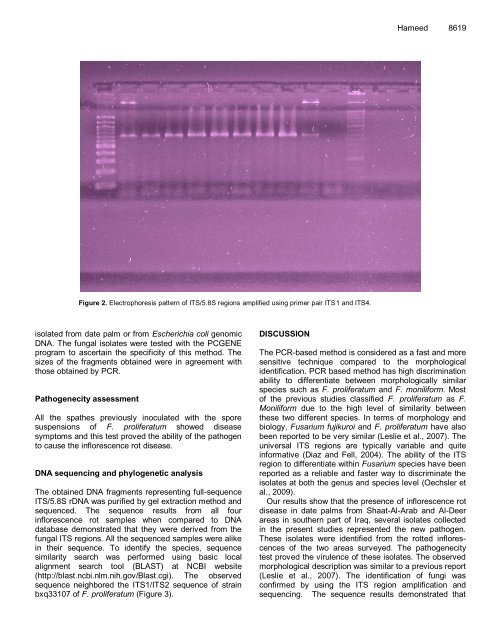Inflorescence rot disease of date palm is caused by Fusarium ...
Inflorescence rot disease of date palm is caused by Fusarium ...
Inflorescence rot disease of date palm is caused by Fusarium ...
Create successful ePaper yourself
Turn your PDF publications into a flip-book with our unique Google optimized e-Paper software.
Figure 2. Electrophores<strong>is</strong> pattern <strong>of</strong> ITS/5.8S regions amplified using primer pair ITS1 and ITS4.<br />
<strong>is</strong>olated from <strong>date</strong> <strong>palm</strong> or from Escherichia coli genomic<br />
DNA. The fungal <strong>is</strong>olates were tested with the PCGENE<br />
program to ascertain the specificity <strong>of</strong> th<strong>is</strong> method. The<br />
sizes <strong>of</strong> the fragments obtained were in agreement with<br />
those obtained <strong>by</strong> PCR.<br />
Pathogenecity assessment<br />
All the spathes previously inoculated with the spore<br />
suspensions <strong>of</strong> F. proliferatum showed <strong>d<strong>is</strong>ease</strong><br />
symptoms and th<strong>is</strong> test proved the ability <strong>of</strong> the pathogen<br />
to cause the inflorescence <strong>rot</strong> <strong>d<strong>is</strong>ease</strong>.<br />
DNA sequencing and phylogenetic analys<strong>is</strong><br />
The obtained DNA fragments representing full-sequence<br />
ITS/5.8S rDNA was purified <strong>by</strong> gel extraction method and<br />
sequenced. The sequence results from all four<br />
inflorescence <strong>rot</strong> samples when compared to DNA<br />
database demonstrated that they were derived from the<br />
fungal ITS regions. All the sequenced samples were alike<br />
in their sequence. To identify the species, sequence<br />
similarity search was performed using basic local<br />
alignment search tool (BLAST) at NCBI website<br />
(http://blast.ncbi.nlm.nih.gov/Blast.cgi). The observed<br />
sequence neighbored the ITS1/ITS2 sequence <strong>of</strong> strain<br />
bxq33107 <strong>of</strong> F. proliferatum (Figure 3).<br />
DISCUSSION<br />
Hameed 8619<br />
The PCR-based method <strong>is</strong> considered as a fast and more<br />
sensitive technique compared to the morphological<br />
identification. PCR based method has high d<strong>is</strong>crimination<br />
ability to differentiate between morphologically similar<br />
species such as F. proliferatum and F. moniliform. Most<br />
<strong>of</strong> the previous studies classified F. proliferatum as F.<br />
Moniliform due to the high level <strong>of</strong> similarity between<br />
these two different species. In terms <strong>of</strong> morphology and<br />
biology, <strong>Fusarium</strong> fujikuroi and F. proliferatum have also<br />
been reported to be very similar (Leslie et al., 2007). The<br />
universal ITS regions are typically variable and quite<br />
informative (Diaz and Fell, 2004). The ability <strong>of</strong> the ITS<br />
region to differentiate within <strong>Fusarium</strong> species have been<br />
reported as a reliable and faster way to d<strong>is</strong>criminate the<br />
<strong>is</strong>olates at both the genus and species level (Oechsler et<br />
al., 2009).<br />
Our results show that the presence <strong>of</strong> inflorescence <strong>rot</strong><br />
<strong>d<strong>is</strong>ease</strong> in <strong>date</strong> <strong>palm</strong>s from Shaat-Al-Arab and Al-Deer<br />
areas in southern part <strong>of</strong> Iraq, several <strong>is</strong>olates collected<br />
in the present studies represented the new pathogen.<br />
These <strong>is</strong>olates were identified from the <strong>rot</strong>ted inflorescences<br />
<strong>of</strong> the two areas surveyed. The pathogenecity<br />
test proved the virulence <strong>of</strong> these <strong>is</strong>olates. The observed<br />
morphological description was similar to a previous report<br />
(Leslie et al., 2007). The identification <strong>of</strong> fungi was<br />
confirmed <strong>by</strong> using the ITS region amplification and<br />
sequencing. The sequence results demonstrated that

















